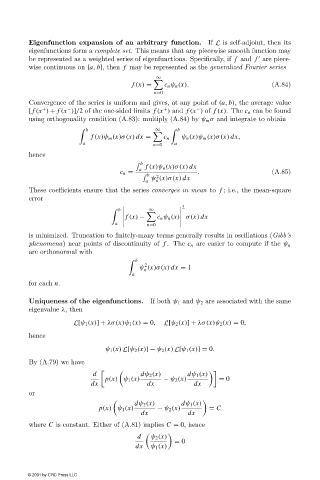Page 488 - Electromagnetics
P. 488
Eigenfunction expansion of an arbitrary function. If L is self-adjoint, then its
eigenfunctions form a complete set. This means that any piecewise smooth function may
be represented as a weighted series of eigenfunctions. Specifically, if f and f are piece-
wise continuous on [a, b], then f may be represented as the generalized Fourier series
∞
f (x) = c n ψ n (x). (A.84)
n=0
Convergence of the series is uniform and gives, at any point of (a, b), the average value
[ f (x )+ f (x )]/2 of the one-sided limits f (x ) and f (x ) of f (x). The c n can be found
−
−
+
+
using orthogonality condition (A.83): multiply (A.84) by ψ m σ and integrate to obtain
b ∞ b
f (x)ψ m (x)σ(x) dx = c n ψ n (x)ψ m (x)σ(x) dx,
a n=0 a
hence
b
a f (x)ψ n (x)σ(x) dx
c n = . (A.85)
b 2
n
a ψ (x)σ(x) dx
These coefficients ensure that the series converges in mean to f ; i.e., the mean-square
error
2
∞
b
f (x) − c n ψ n (x) σ(x) dx
a
n=0
is minimized. Truncation to finitely-many terms generally results in oscillations (Gibb’s
phenomena) near points of discontinuity of f . The c n are easier to compute if the ψ n
are orthonormal with
b
2
ψ (x)σ(x) dx = 1
n
a
for each n.
Uniqueness of the eigenfunctions. If both ψ 1 and ψ 2 are associated with the same
eigenvalue λ, then
L[ψ 1 (x)] + λσ(x)ψ 1 (x) = 0, L[ψ 2 (x)] + λσ(x)ψ 2 (x) = 0,
hence
ψ 1 (x) L[ψ 2 (x)] − ψ 2 (x) L[ψ 1 (x)] = 0.
By (A.79) we have
d dψ 2 (x) dψ 1 (x)
p(x) ψ 1 (x) − ψ 2 (x) = 0
dx dx dx
or
dψ 2 (x) dψ 1 (x)
p(x) ψ 1 (x) − ψ 2 (x) = C
dx dx
where C is constant. Either of (A.81) implies C = 0, hence
d ψ 2 (x)
= 0
dx ψ 1 (x)
© 2001 by CRC Press LLC

